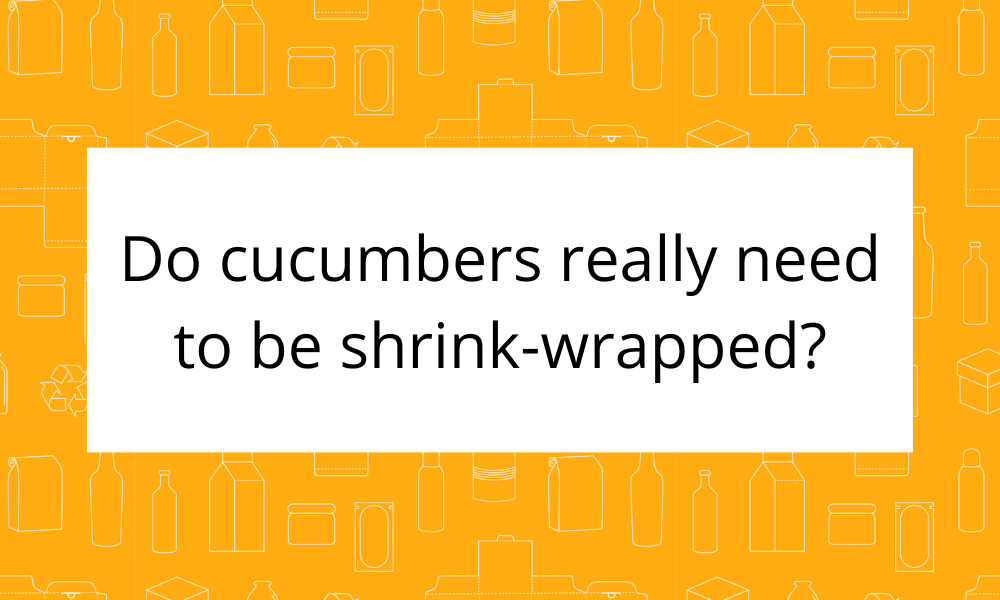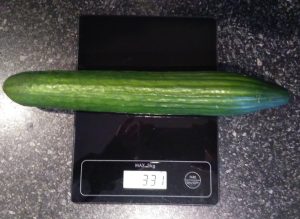Retailers are under enormous pressure to eliminate plastic packaging altogether. Do cucumbers really need to be shrink-wrapped with plastic? Read on to find out…
OK, so most people know that if you keep a cucumber wrapped it will stay fresher for longer. If you are curious like me about by how much, here is an easy experiment you can do at home to see what difference the plastic shrink-wrap makes;
Experiment
Get hold of 2 cucumbers of similar size and the same best before date. Weigh them both using kitchen scales and remove the shrink-wrap from one and weigh the packaging. Put both cucumbers in the fridge and continue weigh every day (more often if you like) until the best-before date. On the best before date, weigh the cucumbers one final time, take a slice from each and taste. (For one way to use up your cucumbers at the end of the experiment, try this recipe for cucumber soup from Delia)
Here are my results, weight of the cucumber plotted vs time;
The wrapped cucumber lost just 1g during the testing period, the unwrapped 12g – 3.5% of its total weight on the day of purchase (day 0) on the graph above. The unwrapped cucumber was still fresh but less crunchy than the wrapped cucumber.
What does this mean?
Shrink-wrap isn’t just a barrier to moisture-loss. After harvest all fresh produce continues to respire (breath) – its carbohydrate reacts with oxygen in the atmosphere and releases carbon dioxide and water (see here for more info). Shrink-wrapping reduces the amount of oxygen available so the cucumber’s respiration rate slows down, less water is lost and it stays fresh for longer. (Note a number of factors also affect the respiration rate – the variety, ripeness of the cucumber when picked, wax coatings and storage conditions).
These particular cucumbers came from Greece, so were picked, wrapped and labelled in Greece, loaded onto a truck, travelled 2000 miles including a trip over the sea to a UK distribution centre and then from the UK DC to the local stores. This can’t take any less than 2 days. Even with temperature controlled transport the temperature the cucumbers are kept at will vary. In many cases (as with these) they are sold and stored at room temperature, so respiration and water-loss will be greater during the time they are on sale. The shrink also physically protects the fruits from damage during transit.
OK, so the home-experiment above was just a bit of fun (yes I know, I need to get out more). However, the Co‑op, regarded as one of the greener supermarket retailers for packaging, performed a rigorous trial across the whole supply chain in 2012. Their trials showed that the shrink-wrap prevented waste by two-thirds (See this article from Sky News). Extensive scientific research has also been performed – see this report from the Journal of Food Science and Technology.
So what next?
Just 2g of plastic means that a cucumber can be as fresh on its best before date as on the day it was purchased, not to mention the protection it provides during a 2000 mile journey to our fridges. This doesn’t mean the industry should not act in order to reduce plastic usage, but until they find a workable solution, the best thing we as consumers can do is to keep the pressure on retailers to reduce plastic packaging where they can. What about the wrappers on soap bar and tinned tuna multi-packs – are they really necessary?
If you are a brand owner and want help in removing plastic packaging from your products contact me for advice or call +44 (0) 7826 791 045
Subscribe to my newsletter to find out more about packaging in general.
In the meantime I’m off to eat some cucumber soup!







